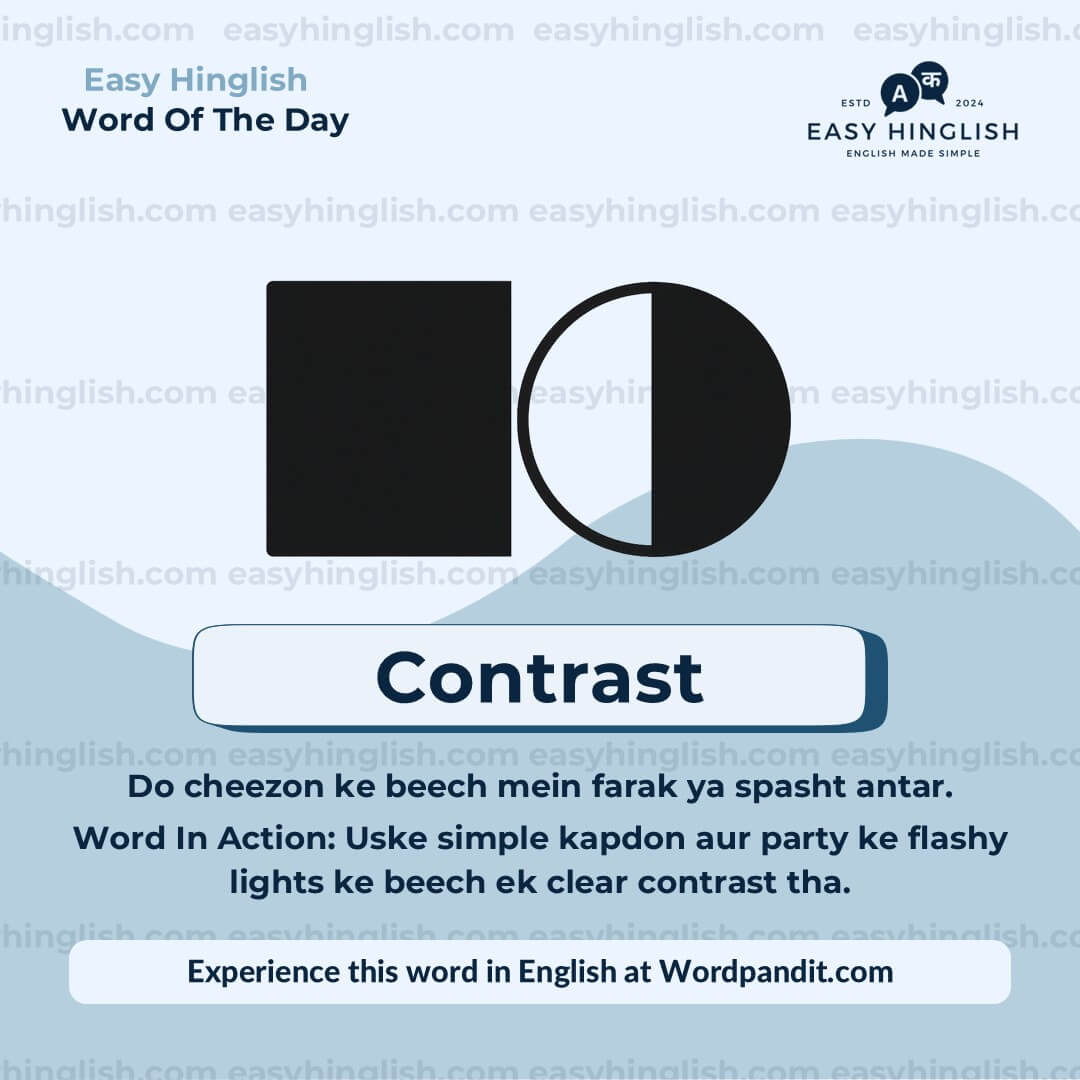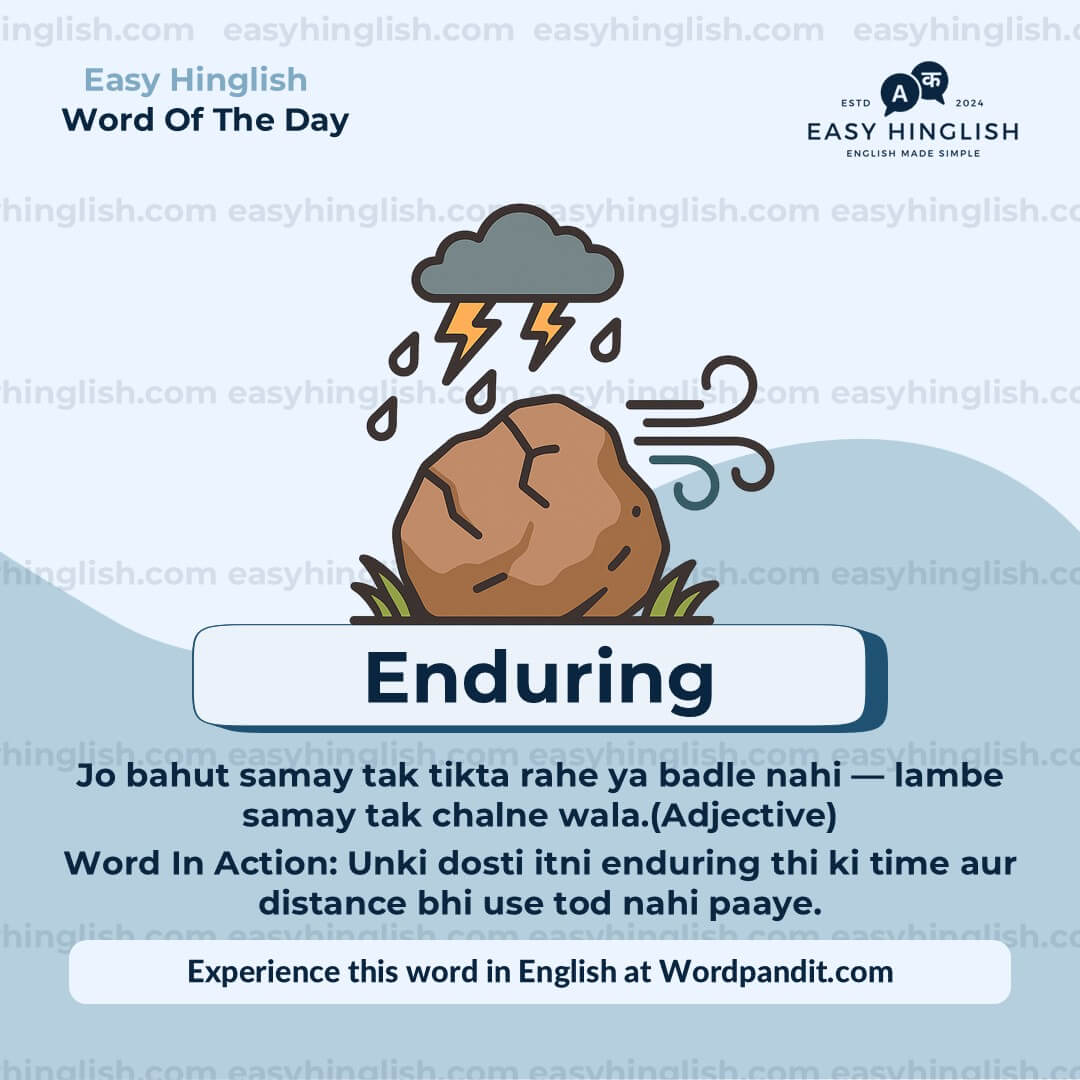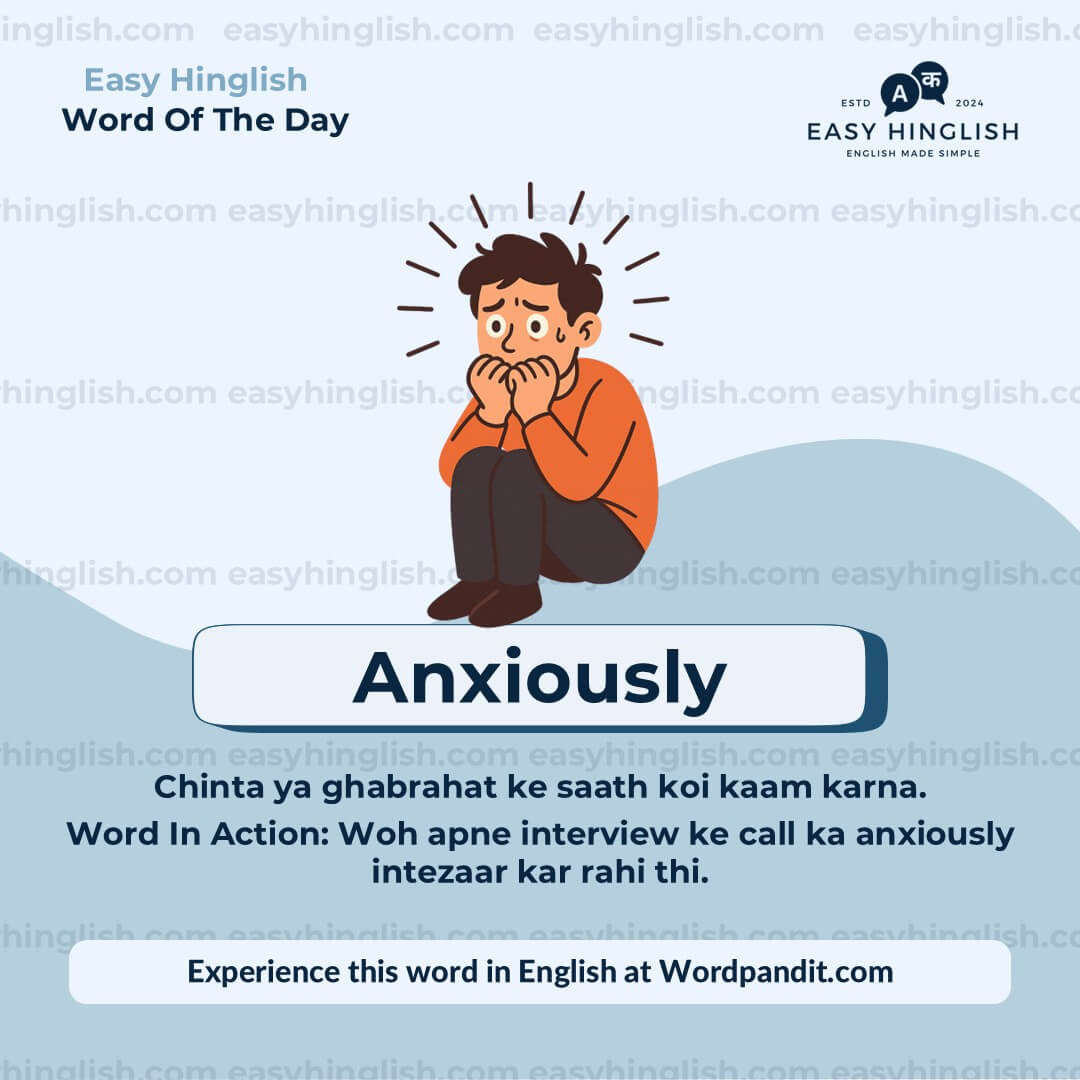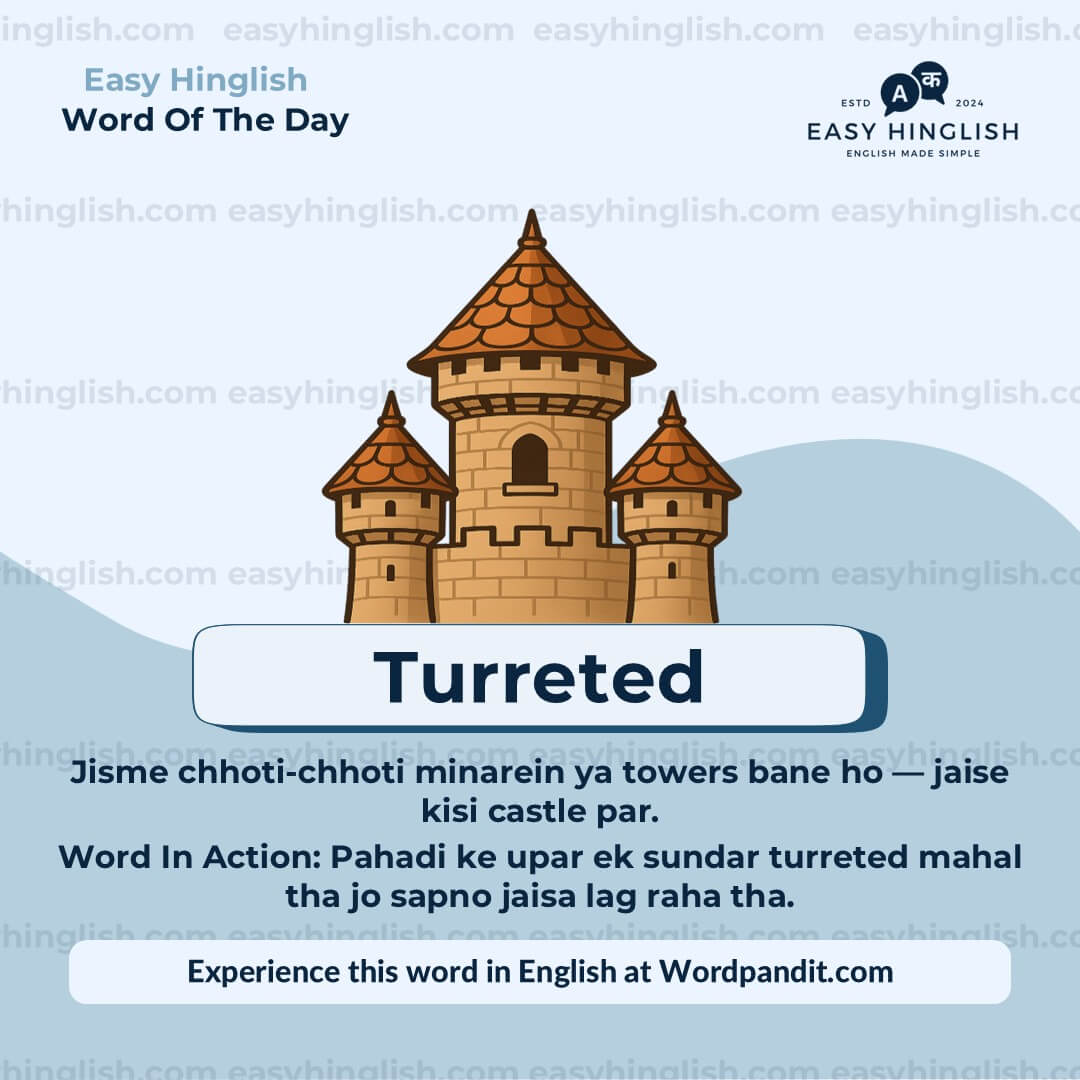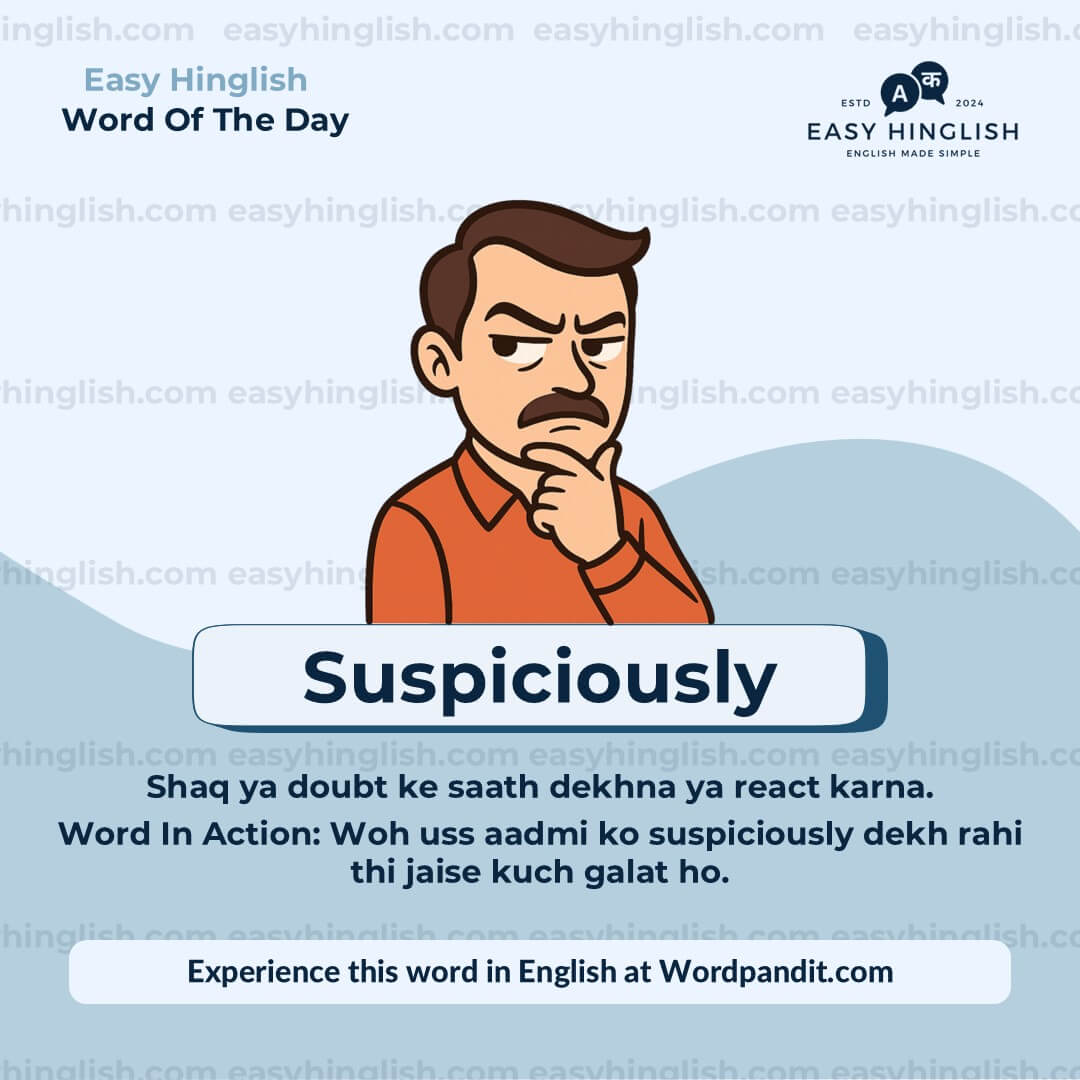Daily Vocabulary Indian Newspapers aur Publications se Seekho
Welcome to Wordpandit ka Indian Vocabulary Hub
Wordpandit par, hum samajhte hain ki ek achhi vocabulary develop karne ke liye local context samajhna bhi zaroori hai. Is section ka focus hai aapke vocabulary ko India ke leading newspapers aur publications se naye shabdon aur phrases ke zariye improve karna, taaki aap practical, relevant, aur uniquely Indian words seekh sakein.
Indian Sources Itne Important Kyun Hain?
Hum maante hain ki kisi bhi language ko sikhne ka sabse best tareeka hai uske local content me immerse hona. Isi wajah se hum carefully words curate karte hain top Indian newspapers aur publications se, jaise:
- The Hindu
- The Times of India
- The Economic Times
- Hindustan Times
- Live Mint
- The Indian Express
- Aur bhi bahut saare...
Hamesha Updated Raho, Hamesha Relevant Raho
Daily updates ke saath, aap Indian news sources se naye words seekhoge jo Indian society aur culture ke latest trends ko reflect karte hain. Hamara focus hai aise words provide karna jo aapke liye real-world me useful ho.
Wordpandit Aapke Learning Goals Ko Kaise Support Karta Hai?
Chahe aap exams ki preparation kar rahe ho, professional communication improve karna chahte ho, ya sirf naye words seekhna chahte ho, Wordpandit har step par aapki madad karega.
Practical Tareeke Se Seekho
Hamari interactive learning methodology me real-world examples, engaging activities, aur context-based usage shamil hain, taaki har naya shabd aapki active vocabulary ka hissa ban sake.
Aaj Hi Indian Vocabulary Seekhna Shuru Karo!
Wordpandit Kyun Choose Karein?
Practical Learning: Aise words seekho jo aapko real-world reading aur communication me sach me kaam aayenge, taaki aapki comprehension aur bolne ki skills improve ho.
Diverse Content: Current affairs se lekar scientific breakthroughs tak, hamare different sources aapko multiple domains ka vocabulary sikhate hain.
Effortless Integration: Wordpandit ko apni daily routine ka part banao. Sirf kuch minute har din dene se aapki vocabulary time ke saath kaafi improve ho sakti hai.
Aapka Vocabulary Mastery Tak Ka Safar
- Regularly hamare Daily Vocabulary section ko visit karo
- Naye words explore karo aur unka context me use samjho
- In words ko apni writing aur bolne ki practice me use karne ki koshish karo
- Jaise-jaise aapke words badhte hain, apni progress ko track karo
Aaj Se Apni Vocabulary Journey Shuru Karo!
Wordpandit ke saath vocabulary improve karna start karo. Roz thoda effort dalne se aap ek strong vocabulary develop kar sakte ho jo academic, professional, aur personal life me kaafi kaam aayegi.
Yaad rakho, ek naya shabd roz seekhna linguistic limitations ko door karne ka best tareeka hai! Wordpandit ko apni daily learning journey ka sathi banao aur vocabulary excellence ki taraf badho!
WORD-1: Contrast
Sandarbh (Context):
"...the contrasting bitterness from the kasuri methi..." - The Indian Express
Vyakhya (Explanatory Paragraph):
Contrast ka matlab hai do cheezein jo ek dusre se bilkul alag ya opposite hain, unka comparison ya farak dikhana. Yeh word tab use hota hai jab aap differences highlight karna chahte hain—jaise colors mein, flavors mein, opinions mein, ya situations mein. Contrast ka upyog kab hota hai? Mainly formal writing, news articles, food reviews, art discussions aur competitive exam passages mein jahan comparisons ya differences emphasize karne hon. CAT aur GRE Reading Comprehension mein contrast signal words bahut important hote hain kyunki yeh author ki argument structure samajhne mein madad karte hain.
Arth (Meaning): Do cheezon ke beech mein farak ya spasht antar.
Uccharan (Pronunciation): KON-trast (noun), kun-TRAST (verb) / कॉन्ट्रास्ट
Kathinai Star (Difficulty Level): ⭐⭐ Basic se Intermediate
Utpatti (Etymology): Contrast Latin word 'contrastare' se aaya hai jiska matlab hai 'khada hona against'—'contra' (against) aur 'stare' (to stand). Renaissance art criticism mein yeh word popular hua jab artists light aur shadow ke differences discuss karte the. Ab yeh word har field mein use hota hai jahan bhi differences ya opposites ko highlight karna ho—food se lekar politics tak.
Prashant Sir Ke Tathya (Prashant Sir's Notes):
Bahut students contrast ko compare se confuse karte hain—dono comparison hain lekin contrast aur compare mein kya farak hai? Compare similarities aur differences dono dikhata hai, jabki contrast specifically differences ya opposites par focus karta hai. CAT aur GRE ke RC passages mein 'in contrast', 'by contrast', 'contrasting with' jaise phrases author ki argument shifts ko signal karte hain—yeh transition words hai jo opposite viewpoint ya contradictory evidence introduce karte hain. Contrast ka sahi istemal kaise karein: Noun ke roop mein 'the contrast between X and Y' bolte hain, aur verb ke roop mein 'X contrasts with Y' ya 'to contrast X with Y'. Indian food reviews mein aapko aksar 'contrasting flavors' aur 'contrasting textures' milega—yeh culinary writing ka essential vocabulary hai.
Samanarthi & Vipritarthi (Synonyms & Antonyms):
Samanarthi (Synonyms): difference, distinction, disparity, divergence, dissimilarity, opposition, antithesis, farak, vipritata, alag
Vipritarthi (Antonyms): similarity, resemblance, likeness, sameness, uniformity, samanta
Udaharan (Usage Examples):
- Mumbai ki fast-paced lifestyle Goa ke relaxed beach culture ke saath sharp contrast mein hai, dono cities ka apna unique charm hai.
- Infosys ke quarterly results previous year ke performance ke saath stark contrast mein the—profit margins significantly improve ho gaye the.
- Article mein author ne urban aur rural education systems ko contrast kiya hai, highlighting funding disparities aur infrastructure gaps.
- Priya ka cheerful personality uske bhai Rohit ke serious nature se bilkul contrast karta hai, lekin dono bahut close hain.
Sanskritik Sandarbh (Cultural Reference):
"Indian cinema mein light aur darkness ka contrast symbolism create karta hai—jaise Sholay mein Gabbar ka dark character Thakur ke righteous persona se contrast karta tha, good versus evil ko visually represent karte hue." - Film analysis tradition
Sochiye (Think About It):
India mein traditional values aur modern lifestyle ka contrast har generation mein kaise evolve kar raha hai? Kya yeh contrast conflict create karta hai ya richness add karta hai?
Chhoti Kriya (Quick Activity):
Apne aas-paas teen contrasting pairs dhoondhein—jaise street food aur fine dining, local train aur metro, joint family aur nuclear family—aur har pair ke liye ek sentence likhein jo unka contrast clearly dikhaye.
Yaad Karne Ka Tarika (Memory Tip):
'Contrast' ko aise yaad rakhein: 'CON-TRAST' mein 'CON' matlab 'against' (jaisa 'conflict' mein)—imagine karo two Bollywood heroes ek dusre ke AGAINST khade hain, bilkul opposite personalities ke saath. Jaise SRK ka romantic hero Sunny Deol ke action hero se contrast karta hai!
Vastavik Jeevan Me Upyog (Real-World Application):
Contrast commonly business presentations, marketing campaigns, academic essays aur food reviews mein use hota hai comparisons emphasize karne ke liye. Graphic designers color contrast use karte hain visual impact badhane ke liye. News analysis mein journalists government policies ko ground realities se contrast karte hain discrepancies dikhane ke liye. Corporate communications mein 'in contrast to our competitors' phrase competitive advantage highlight karne ke liye essential hai. Exam essays mein strong contrast signal words (however, on the other hand, conversely) argument structure strengthen karte hain.
WORD-2: Enduring
Sandarbh (Context):
"...that gives this dish its enduring grip on my palate." - The Indian Express
Vyakhya (Explanatory Paragraph):
Enduring ka matlab hai jo lamba samay tak tikta hai, jo mushkilon ke bawajood bana rehta hai ya continue karta hai. Yeh word tab use hota hai jab aap kisi cheez ki permanence, resilience ya time ke saath survive karne ki quality describe karna chahte hain. Enduring kaise use karte hain? Mainly formal writing, literary analysis aur competitive exam passages mein jahan lasting qualities, persistent characteristics ya aise cheezein describe karni hon jo generations tak relevant rehti hain—enduring friendships se lekar enduring cultural traditions tak.
Arth (Meaning): Jo bahut samay tak tikta rahe ya badle nahi — lambe samay tak chalne wala. (Adjective)
Uccharan (Pronunciation): en-DYOOR-ing / एन्ड्योरिंग
Kathinai Star (Difficulty Level): ⭐⭐⭐ Intermediate
Utpatti (Etymology): Enduring Latin word 'indurare' se aaya hai jiska matlab hai 'hard banana,' Old French 'endurer' ke through jiska sense tha 'last karna ya continue karna.' Yeh word physical sense se—hardening ya toughening—metaphorical sense mein evolve hua, ab iska matlab hai time ke saath tikna ya difficulties survive karna, emphasizing resilience aur permanence.
Prashant Sir Ke Tathya (Prashant Sir's Notes):
Bahut students enduring ko endearing se confuse karte hain—endearing aur enduring mein kya farak hai? Endearing ka matlab hai 'lovable ya charming,' jabki enduring specifically longevity aur persistence emphasize karta hai. Enduring aur lasting mein subtle difference hai: enduring mein challenges ya hardships survive karne ka stronger connotation hota hai, jabki lasting simply means continuing over time. UPSC aur CAT ke students ke liye, enduring aksar cultural heritage, historical significance ya timeless values ke passages mein dikhta hai. Enduring ka sahi istemal: yeh typically nouns se pehle aata hai jo abstract qualities represent karte hain—"enduring legacy," "enduring appeal," ya "enduring impact." Indian newspapers mein aapko aksar "enduring popularity of cricket" ya "enduring influence of Gandhi" milega—contexts jahan koi cheez changing times ke bawajood strong rehti hai.
Samanarthi & Vipritarthi (Synonyms & Antonyms):
Samanarthi (Synonyms): lasting, permanent, durable, persistent, continuing, timeless, abiding, perennial, immortal, everlasting, स्थायी, chirasthaayi
Vipritarthi (Antonyms): temporary, fleeting, transient, ephemeral, short-lived, passing, kshanik, अस्थायी
Udaharan (Usage Examples):
- Sholay aur Mughal-e-Azam jaise classic Bollywood films ki enduring appeal aaj bhi audiences ko attract karti hai, paanch decades ke baad bhi.
- Technological disruptions ke bawajood, Indian classical music ne country ke cultural landscape mein apni enduring presence maintain rakhi hai consistently.
- Tagore ki poetry mein humanity ka enduring message hai jo generations aur geographical boundaries ko cross karke resonate karta hai.
- Ramesh aur Sunil ki college days mein bani enduring friendship ne distance, career changes aur life ki har mushkil ko survive kiya hai.
Sanskritik Sandarbh (Cultural Reference):
"Mahatma Gandhi ke non-violence principles ki enduring legacy aaj bhi worldwide social movements ko inspire karti hai, unki death ke decades baad bhi." - Indian political discourse ka common theme
Sochiye (Think About It):
Kuch traditions, values ya relationships enduring kyun hote hain jabki doosre time ke saath fade ho jate hain? Kya yeh unki inherent quality hai ya phir woh effort jo hum unhe preserve karne mein lagate hain?
Chhoti Kriya (Quick Activity):
Indian culture mein teen aise cheezein list karein jo modernization ke bawajood enduring popularity dikhati hain. Har ek ke liye ek sentence likhein jo explain kare ki use kya enduring banata hai.
Yaad Karne Ka Tarika (Memory Tip):
'Enduring' ko tod ke dekho: 'EN-DURING'—imagine karo koi cheez abhi bhi "during" (continue) kar rahi hai lambe time ke baad bhi. India Gate ko visualize karo jo decades se tall khada hai—ek enduring monument jo history witness kar chuka hai lekin unchanged rehta hai, symbolizing permanence aur resilience.
Vastavik Jeevan Me Upyog (Real-World Application):
Business writing aur brand communications mein, "enduring" crucial hai long-term value propositions, legacy brands ya sustainable competitive advantages describe karne ke liye. Historians aur cultural critics iska use civilization ke kon se aspects persist karte hain changing eras ke through—yeh analyze karne ke liye karte hain. GRE aur CAT Reading Comprehension passages mein, "enduring" identify karna aapko author ki perspective samajhne mein madad karta hai ki unke liye kya lasting significance rakhta hai versus temporary trends. Yeh word frequently heritage conservation, timeless literature aur institutional stability ki discussions mein appear hota hai.
WORD-3: Anxiously
Sandarbh (Context):
"...I have waited anxiously among the dark shadows..." - The Indian Express
Vyakhya (Explanatory Paragraph):
Anxiously ka matlab hai kisi kaam ko ghabrahat, nervousness ya beचैनी ke saath karna, especially jab outcome uncertain ho. Yeh word tab use hota hai jab aap kisi action ko apprehension, eager concern ya restless anticipation ke saath describe karna chahte hain. Anxiously ka upyog kab hota hai? Narrative writing, descriptive passages aur competitive exam texts mein jahan characters ki emotional states dikhani hon ya aise situations describe karne hon jahan koi results, news ya events ka wait kar raha ho nervous tension aur worry ke saath.
Arth (Meaning): Chinta ya ghabrahat ke saath koi kaam karna.
Uccharan (Pronunciation): ANGK-shus-lee / ऐंक्शसली
Kathinai Star (Difficulty Level): ⭐⭐ Basic se Intermediate
Utpatti (Etymology): Anxiously Latin word 'anxius' se aaya hai jiska matlab hai 'troubled ya uneasy,' jo 'angere' se derived hai meaning 'choke karna ya distress cause karna.' Old French ke through yeh word evolve hua mental state of worry aur unease describe karne ke liye. '-ly' suffix adjective 'anxious' ko adverb mein transform karta hai, describing kaise koi action nervous anticipation ke saath perform hoti hai.
Prashant Sir Ke Tathya (Prashant Sir's Notes):
Students aksar poochhte hain: anxiously aur eagerly mein kya farak hai? Dono mein anticipation hai, lekin anxiously specifically worry ya fear of negative outcomes carry karta hai, jabki eagerly positive excitement express karta hai. CAT aur GRE ke students ke liye, anxiously frequently narrative passages mein dikhta hai jahan characters stress mein hain ya important decisions ka wait kar rahe hain. Anxiously ka sahi istemal: yeh typically verbs ko modify karta hai jaise "waited," "watched," "checked," ya "listened"—actions jo anxiety experience karte hue ki jaati hain. Indian English mein aapko phrases milenge jaise "parents anxiously awaited board exam results" ya "investors anxiously monitored market fluctuations"—situations jahan anticipation aur apprehension combine hote hain. Yaad rakhein ki anxiously hamesha kuch level of distress imply karta hai, not just simple waiting.
Samanarthi & Vipritarthi (Synonyms & Antonyms):
Samanarthi (Synonyms): nervously, worriedly, uneasily, apprehensively, restlessly, fearfully, tensely, agitatedly, concernedly, fretfully, घबराहट से, बेचैनी से
Vipritarthi (Antonyms): calmly, confidently, peacefully, serenely, tranquilly, composedly, शांति से, आत्मविश्वास से
Udaharan (Usage Examples):
- Meera ne anxiously har kuch minutes mein apna phone check kiya, multinational company se job interview callback ka wait karte hue.
- Cricket fans ne anxiously dekha jab India ko World Cup final jeetne ke liye last over mein twelve runs chahiye the.
- Students anxiously examination hall ke bahar gather hue the, UPSC prelims se pehle possible questions discuss karte hue aur last-minute notes review karte hue.
- Rajesh hospital corridor mein anxiously pace kar raha tha jabki uski wife emergency surgery ke liye operation theater mein thi.
Sanskritik Sandarbh (Cultural Reference):
"India-Pakistan ke crucial cricket matches ke dauran, dono nations mein millions log anxiously dekhte hain, unke emotions har ball ke saath ride karte hain." - Sports commentary mein common observation
Sochiye (Think About It):
Hum aksar results ya outcomes ka anxiously wait kyun karte hain jo already determined hain aur humare control se bahar hain? Kya anxious waiting kuch change karti hai, ya yeh simply human nature hai?
Chhoti Kriya (Quick Activity):
Do sentences likhein jahan aapki life mein kisi ne kisi cheez ka anxiously wait kiya ho. Varied sentence structures use karein aur "anxiously" ke saath different verbs try karein.
Yaad Karne Ka Tarika (Memory Tip):
'Anxiously' ko 'anxiety' se connect karein—socho "ANX-iously" matlab ANXiety se bhare hoke kaam karna. Ek student ko visualize karo jo nails bite kar raha hai aur exam results website ko repeatedly check kar raha hai, har kuch seconds mein anxiously page refresh karte hue. Yeh physical restlessness meaning ko perfectly capture karti hai.
Vastavik Jeevan Me Upyog (Real-World Application):
Creative writing aur journalistic narratives mein, "anxiously" effectively emotional tension convey karta hai aur suspense build karta hai. News reporters iska use public sentiment describe karne ke liye karte hain elections, exam seasons ya crisis situations ke dauran. Business communications mein yeh contexts mein appear hota hai jaise "stakeholders anxiously await quarterly results" ya "employees anxiously anticipate restructuring announcements." Competitive exam essays ke liye, "anxiously" use karna emotional depth add karta hai jab aap characters' mental states ya societal reactions to uncertain situations describe kar rahe ho, making your writing more vivid aur engaging.
WORD-4: Turreted
Sandarbh (Context):
"...the fake-historic turreted 'trucker's castle' near Frankfurt..." - The Indian Express
Vyakhya (Explanatory Paragraph):
Turreted ka matlab hai jisme turrets ya छोटे towers hon, jo typically castles, fortresses ya medieval architectural style ke buildings mein milte hain. Yeh word tab use hota hai jab aap aise structures describe karte hain jinmein projecting tower-like structures hain, jo ya toh defensive purposes ke liye hon ya decorative effect ke liye. Turreted kaise use karte hain? Mainly architectural descriptions, travel writing aur literary passages mein jahan castles, fortresses ya distinctive tower features wali buildings ko describe karna ho jo structure mein grandeur ya historical character add karte hain.
Arth (Meaning): Turrets ya छोटे मीनारों वाला; chhote towers ya tower-like projections se furnished (Adjective)
Uccharan (Pronunciation): TUR-it-ed / टरिटेड
Kathinai Star (Difficulty Level): ⭐⭐⭐ Intermediate
Utpatti (Etymology): Turreted Latin word 'turris' se aaya hai jiska matlab hai 'tower,' Old French 'tourette' ke through (jo 'tour' meaning tower ka diminutive hai). Yeh word medieval architectural terminology mein evolve hua buildings describe karne ke liye jinmein small defensive ya decorative towers hote hain. '-ed' suffix in architectural features ki presence indicate karta hai, noun 'turret' ko descriptive adjective mein transform karte hue castle-like structures ke liye.
Prashant Sir Ke Tathya (Prashant Sir's Notes):
Bahut students turreted ko towering se confuse karte hain—towering ka matlab hai 'bahut tall ya high,' lekin turreted aur towering mein kya farak hai? Turreted specifically un buildings ko describe karta hai jinmein small tower-like projections ya turrets architectural features ke roop mein hon. GRE aur GMAT ke students ke liye, turreted descriptive passages mein dikhta hai jo architecture, historical buildings ya imposing structures ke metaphorical descriptions ke baare mein hoti hain. Turreted ka sahi istemal: yeh primarily pre-modifier ke roop mein nouns se pehle use hota hai jaise "turreted castle," "turreted mansion," ya "turreted fortress." Indian English contexts mein aapko "turreted palace" mil sakta hai Rajasthani forts describe karte waqt ya "turreted colonial buildings" Indo-Gothic architecture ke descriptions mein. Yeh word instantly medieval imagery evoke karta hai aur architectural descriptions mein grandeur ya historical authenticity ka sense add karta hai—ya context example ki tarah, ironic fake grandeur.
Samanarthi & Vipritarthi (Synonyms & Antonyms):
Samanarthi (Synonyms): towered, castellated, fortified, battlemented, castle-like, fortress-like, medieval-style, tower-crowned, बुर्जदार, मीनारों वाला
Vipritarthi (Antonyms): flat-roofed, plain, unadorned, simple, modern, minimalist, सादा, सरल
Udaharan (Usage Examples):
- Turreted Mysore Palace Indo-Saracenic architecture ka ek magnificent example hai jo duniya bhar se tourists ko attract karta hai apni grandeur se.
- Mumbai ke wealthy industrialists ne colonial era mein turreted mansions banaye the, European castle architecture mimic karte hue apna status display karne ke liye.
- Author ne villain ke headquarters ko ek turreted fortress ke roop mein describe kiya jo menacingly cliff par perched tha overlooking the stormy sea.
- Rajasthan ke bahut heritage hotels mein turreted structures hain jo guests ko maharajas aur royal courts ke era mein transport kar dete hain.
Sanskritik Sandarbh (Cultural Reference):
"Jodhpur ka turreted Mehrangarh Fort, apne imposing ramparts aur decorative turrets ke saath, Rajputana heritage ki architectural grandeur represent karta hai." - Indian tourism literature mein common description
Sochiye (Think About It):
Modern buildings mein kabhi-kabhi turreted designs kyun incorporate kiye jate hain jabki unka koi defensive purpose nahi hota? Yeh historical architecture aur power ki symbolism ke prati humari fascination ke baare mein kya reveal karta hai?
Chhoti Kriya (Quick Activity):
Teen famous Indian forts ya palaces ki images dekho. Identify karo ki kaun se turreted hain aur har structure ke liye ek sentence likho describing kaise turrets overall appearance mein contribute karte hain.
Yaad Karne Ka Tarika (Memory Tip):
'Turreted' ko "TURRET-ed" ki tarah socho—imagine karo ek building jisme turrets "add" kar diye gaye hain, matlab woh "turret-ted" ho gayi hai. Rajasthani forts ko visualize karo unke distinctive chhote towers ke saath jo corners par poke out karte hain—woh turrets hain, jo building ko turreted banate hain. Ya chess ke rook piece ko picture karo, jo turret jaisa dikhta hai!
Vastavik Jeevan Me Upyog (Real-World Application):
Travel writing aur architectural criticism mein, "turreted" efficiently medieval ya castle-like structures ki specific visual image convey karta hai. Real estate descriptions mein iska use tower features wali properties mein charm aur historical appeal add karne ke liye hota hai. Literature mein, turreted buildings aksar power, mystery ya Gothic atmosphere symbolize karti hain—fantasy novels ya horror stories mein turreted castles socho. Competitive exam comprehension passages ke liye, "turreted" recognize karna aapko setting visualize karne mein madad karta hai aur author ki tone samajhne mein, chahe woh authentic historical architecture describe kar rahe hon ya, context example ki tarah, fake-historic pastiche constructions ka mazaak uda rahe hon.
WORD-5: Suspiciously
Sandarbh (Context):
"...the suspiciously watery maccher jhol..." - The Indian Express
Vyakhya (Explanatory Paragraph):
Suspiciously ka matlab hai kisi cheez ko aise tarike se karna ya dikhna jo शंका ya doubt paida kare, jisse lagta hai ki kuch galat hai ya जैसा होना चाहिए waisa nahi hai. Yeh word tab use hota hai jab aap actions, appearances ya situations describe karte hain jo authenticity ya quality ke baare mein doubt ya mistrust create karte hain. Suspiciously ka upyog kab hota hai? Descriptive writing, investigative reports aur everyday conversations mein jahan skepticism express karni ho ya indicate karna ho ki koi cheez dubious, irregular ya potentially deceptive nature ki lag rahi hai.
Arth (Meaning): Shaq ya doubt ke saath dekhna ya react karna.
Uccharan (Pronunciation): suh-SPISH-us-lee / सस्पिशसली
Kathinai Star (Difficulty Level): ⭐⭐ Basic se Intermediate
Utpatti (Etymology): Suspiciously Latin word 'suspicere' se derive hua hai jiska matlab hai 'look up at' ya 'mistrust,' jo 'sub' (from below) aur 'specere' (to look) se formed hai. Old French 'suspicion' ke through, yeh word evolve hua doubt ya distrust ke saath kisi cheez ko dekhne ki act describe karne ke liye. '-ly' suffix ek adverb banata hai jo describe karta hai ki actions kaise appear hote hain jab woh questionable lagte hain ya mistrust arousing karte hain.
Prashant Sir Ke Tathya (Prashant Sir's Notes):
Bahut students suspiciously ko surprisingly se confuse karte hain—surprisingly unexpectedness indicate karta hai, lekin suspiciously aur surprisingly mein kya farak hai? Suspiciously specifically doubt ya mistrust convey karta hai ki kuch galat lag raha hai. Suspiciously aur dubiously mein subtle difference hai: suspiciously suggest karta hai ki something actively suspicion arouse kar raha hai, jabki dubiously observer ke skeptical attitude ko imply karta hai. CAT aur GRE ke students ke liye, suspiciously frequently detective stories, quality assessments ya aise situations ke passages mein dikhta hai jahan cheezein waisi nahi hain jaisi appear karti hain. Suspiciously ka sahi istemal: yeh typically adjectives ko modify karta hai ("suspiciously quiet"), verbs ko ("looked suspiciously"), ya phrases mein appear hota hai jaise "suspiciously similar" ya "suspiciously convenient." Indian English contexts mein aapko aksar yeh humorously food quality, exam questions jo bahut easy lagte hain, ya deals jo too good to be true lagte hain—iske baare mein milta hai. Context example perfectly yeh skeptical tone capture karta hai substandard food preparation ke baare mein.
Samanarthi & Vipritarthi (Synonyms & Antonyms):
Samanarthi (Synonyms): questionably, dubiously, doubtfully, mistrustfully, skeptically, shadily, fishily (informal), oddly, strangely, peculiarly, संदेह से, शक के साथ
Vipritarthi (Antonyms): trustingly, confidently, genuinely, authentically, legitimately, credibly, विश्वास से, भरोसे से
Udaharan (Usage Examples):
- Street vendor ke aam suspiciously saste the, jisse Kavita soch rahi thi ki woh overripe hain ya poor quality ke hain kahi.
- Rohit ki suspiciously detailed explanation meeting mein late hone ke liye sirf uske colleagues ka doubt aur badha gayi instead of clearing it.
- Company ke financial records mein suspiciously high profits dikhe ek aise quarter mein jab market conditions sabke liye terrible the.
- Neighborhood suspiciously quiet ho gaya just before surprise monsoon storm hit, jaise nature khud apni saans rok rahi thi waiting for something.
Sanskritik Sandarbh (Cultural Reference):
"Jab koi aapko Delhi ki Janpath par 'genuine' designer bag one-tenth price mein offer kare, toh suspiciously clear hota hai ki aapko actually kya mil raha hai." - Counterfeit markets ke baare mein common observation
Sochiye (Think About It):
Hum immediately suspicious kyun ho jate hain jab koi cheez too good to be true lagti hai? Kya yeh skepticism ek survival instinct hai, ya yeh kabhi-kabhi genuine opportunities recognize karne se rok deti hai?
Chhoti Kriya (Quick Activity):
Do sentences likhein jahan kuch suspiciously galat ya questionable laga ho. Different contexts use karein—ek serious aur ek humorous, jaise context mein food example diya gaya hai.
Yaad Karne Ka Tarika (Memory Tip):
'Suspiciously' ko tod ke dekho: "SUS-SPIC-iously"—socho "SUS" (suspicious, jaise popular "that's sus" slang mein) + "SPIC" (jaise spy checking). Ek detective ko imagine karo jo suspiciously kisi scene ko eye kar raha hai, spying for clues kyunki kuch off lag raha hai. Ya restaurant mein patle watery dal ko picture karo—suspiciously thin, jisse aap sochte hain ki woh corners cut kar rahe hain!
Vastavik Jeevan Me Upyog (Real-World Application):
Journalism aur investigative reporting mein, "suspiciously" red flags signal karta hai jo deeper scrutiny deserve karte hain—suspiciously timed announcements, suspiciously similar proposals, ya suspiciously absent records. Consumer reviews mein iska frequent use hota hai doosron ko questionable products ya services ke baare mein warn karne ke liye. Business communication mein yeh irregularities ya concerns discuss karte waqt appear hota hai: "suspiciously low bids" ya "suspiciously high employee turnover." Exam essays ke liye, "suspiciously" use karna aapki analysis mein critical thinking add karta hai, showing ki aap potentially problematic patterns ya questionable claims identify kar sakte hain arguments ya data mein jo passages mein present kiye gaye hain.



